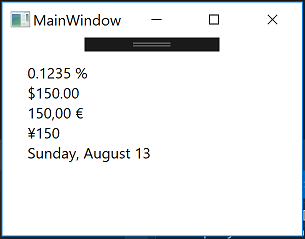WPF中推荐的DisplayFormatAttribute替代方案是什么?
WPF中推荐的DisplayFormatAttribute替代方案是什么?
提问于 2017-08-11 19:07:16
所以我找到了DisplayFormatAttribute类(我想这仅仅是用于Web开发?)。这将真正改善我的项目的可维护性,因为我有许多十进制属性,其小数位数似乎一次又一次地改变(客户需求与我的“聪明”想法混合在一起)。
基本上,我会有这样的财产:
[DisplayFormat(DataFormatString = "{0:n4} %")]
public decimal Nh3 {get; set;}如DisplayFormatAttribute所示,需要在当前用户区域设置中显示四个小数,后面跟着一个%。
在XAML中,我会有这样的东西
<TextBlock Text="{Binding Nh3}"/>但是对于像0.123456这样的值,它将显示0.123456,对于像0.12这样的值,它将显示0.12。我需要它分别显示0.1235 %和0.1200 %。
对于特定的TextBlock,可以通过
<TextBlock Text="{Binding Nh3, StringFormat={}{0:n4} %"/>但正如我所提到的,这是重复和容易出错的.
我看到有人用类似的东西
<TextBlock Text="{Binding Nh3, StringFormat={StaticResource Nh3Format} %"/>但我发现这是相当复杂的(与Nh3属性上的属性相比)。但我希望有人能帮我更好地解决这个问题。
回答 1
Stack Overflow用户
回答已采纳
发布于 2017-08-13 04:41:25
您可以定义自己的DisplayFormatAttribute和自定义标记扩展来自动为您创建这些绑定。
///Custom attribute
[AttributeUsageAttribute(AttributeTargets.Property, AllowMultiple = false)]
public class DisplayFormatAttribute : Attribute
{
public string DataFormatString { get; set; }
}
///Custom markup extension
[ContentProperty("ResourceKey")]
[MarkupExtensionReturnType(typeof(object))]
public class FormattedBindingExtension : MarkupExtension
{
public FormattedBindingExtension()
{
}
public FormattedBindingExtension(PropertyPath path)
{
Path = path;
}
public IValueConverter Converter { get; set; }
public object ConverterParamter { get; set; }
[ConstructorArgument("path")]
public PropertyPath Path { get; set; }
[TypeConverter(typeof(CultureInfoIetfLanguageTagConverter))]
public CultureInfo ConverterCulture { get; set; }
private DependencyProperty _bindingTargetProperty;
public override object ProvideValue(IServiceProvider serviceProvider)
{
var valueProvider = serviceProvider.GetService(typeof(IProvideValueTarget)) as IProvideValueTarget;
if (valueProvider != null)
{
var bindingTarget = valueProvider.TargetObject as DependencyObject;
var bindingTargetProperty = valueProvider.TargetProperty as DependencyProperty;
if (bindingTargetProperty == null || bindingTarget == null || Path == null)
{
throw new NotSupportedException(string.Format(
"The property '{0}' on target '{1}' is not valid for a FormattedBinding. The FormattedBinding target must be a DependencyObject, "
+ "and the target property must be a DependencyProperty, and a Path must be specified.",
valueProvider.TargetProperty,
valueProvider.TargetObject));
}
// Add support so that the datacontext change causes an immediate commit with format
var frameworkElement = bindingTarget as FrameworkElement;
if (frameworkElement != null)
{
frameworkElement.DataContextChanged += FrameworkElement_DataContextChanged;
}
_bindingTargetProperty = bindingTargetProperty;
FrameworkElement_DataContextChanged(frameworkElement, new DependencyPropertyChangedEventArgs());
// Return the current value of the binding (since it will have been evaluated because of the binding above)
return bindingTarget.GetValue(bindingTargetProperty);
}
return null;
}
private void FrameworkElement_DataContextChanged(object sender, DependencyPropertyChangedEventArgs ignored)
{
var element = sender as FrameworkElement;
if (element == null || element.DataContext == null)
return;
var propertyName = Path.Path;
if (propertyName == null)
return;
var source = element.DataContext;
var type = source.GetType();
var property = type.GetProperty(propertyName);
var format = property.GetCustomAttribute<DisplayFormatAttribute>()?.DataFormatString;
Binding binding = GetBinding(format);
// Apply and evaluate the binding
var bindingExpression = BindingOperations.SetBinding(element, _bindingTargetProperty, binding);
bindingExpression.UpdateTarget();
}
private Binding GetBinding(string format)
{
var binding = new Binding();
binding.Path = Path;
binding.Converter = Converter;
binding.ConverterCulture = ConverterCulture;
binding.ConverterParameter = ConverterParamter;
binding.StringFormat = format;
return binding;
}
}样本使用情况:
XAML
<TextBlock Text="{local:FormattedBinding Path=Nh3}" />
<!-- specify price US currency -->
<TextBlock Text="{local:FormattedBinding Path=Price, ConverterCulture='en-US'}" />
<!-- specify price German currency -->
<TextBlock Text="{local:FormattedBinding Path=Price, ConverterCulture='de-DE'}" />
<!-- specify price Japanese currency -->
<TextBlock Text="{local:FormattedBinding Path=Price, ConverterCulture='ja-JP'}" />
<TextBlock Text="{local:FormattedBinding Path=Today}" />ViewModel properties
[DisplayFormat(DataFormatString = "{0:n4} %")]
public double Nh3 { get; set; }
[DisplayFormat(DataFormatString = "{0:C}")]
public decimal Price { get; set; }
[DisplayFormat(DataFormatString = "{0:dddd, MMMM dd}")]
public DateTime Today { get; set; }

页面原文内容由Stack Overflow提供。腾讯云小微IT领域专用引擎提供翻译支持
原文链接:
https://stackoverflow.com/questions/45642239
复制相关文章
相似问题

